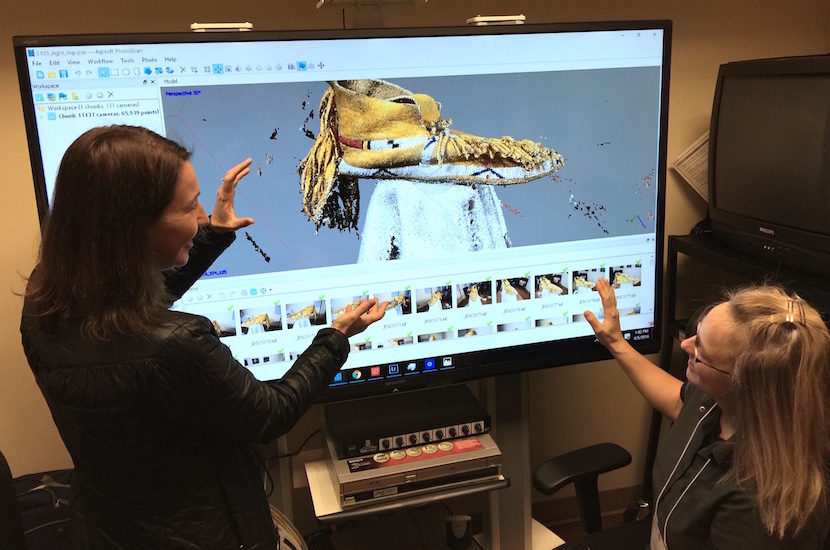Idaho State University and Grand Teton National Park team up to create new 3-D imagery and documentation of Native American artifacts
July 26, 2016

POCATELLO – Idaho State University researchers are working with Grand Teton National Park and various tribes to better document about 50 Native American artifacts from the park’s David T. Vernon Collection and create digital 3-D visualizations of them.
The Vernon Collection consists of more than 1,400 Native American social and cultural objects that were gifted to Grand Teton National Park in 1972 by Laurance S. Rockefeller. ISU researchers Yolonda Youngs, from the global studies department, and Donna Delparte, geosciences, are working with Grand Teton National Park Museum Curator Bridgette Guild on this project funded through the National Center for Preservation Technology and Training.
“These ethnographic objects, some in a fragile state, need a lot of care and conservation, and a lot don’t have much display information,” Youngs said. “Some have basic information, but we want to work with tribes that are represented in this collection and find out what the objects are, what meaning they have and how they are made.”
 Exhibits of these visualizations are planned for future display at the Craig Thomas Discovery and Visitor Center in Grand Teton National Park. The 3-D displays of these objects – such as moccasins, saddle blankets, cradles or shirts – will allow visitors using electronic notebooks or tablets setup by displays to virtually zoom-in, rotate and closely examine them. The ISU researchers have taken hundreds of photos of these objects to create the visualizations.
Exhibits of these visualizations are planned for future display at the Craig Thomas Discovery and Visitor Center in Grand Teton National Park. The 3-D displays of these objects – such as moccasins, saddle blankets, cradles or shirts – will allow visitors using electronic notebooks or tablets setup by displays to virtually zoom-in, rotate and closely examine them. The ISU researchers have taken hundreds of photos of these objects to create the visualizations.
ISU researchers are working the National Park Service and the tribes to develop text and maps to go with the visualizations. Guild conducted consultations with the tribes from throughout the United States to help select objects for 3-D documentation. Cultural and technical information about each object's origin location and creation were collected to aid in better understanding and interpreting these Vernon Collection objects.
This project is about halfway completed and is due to be finished by January. In addition to the visual displays, this project will create new cultural datasets to aid in the creation of interpretive materials about the objects. They will also create training materials for park staff so that other projects and parks can create 3-D imagery for cultural resources and museum collections.
"This project is an excellent example of making a connection between technology and history,” said Denise Germann, public affairs officer, Grand Teton National Park. “University students are learning to incorporate new and fun technology with the history of the artifacts. The 3-D imaging helps to communicate the story about the legacy of Native Americans in the area, as well as the journey these items had through trade, purchase, collection and donation."
Youngs and other ISU researchers are also working with Grand Teton National Park on two other grants to document historic river guides and National Park Service river and mountaineering rangers in the park.
 “We’re looking at the recreation history in the park and helping the National Park Service to create a new archival collection that will eventually be opened to the public, and we’re collecting oral history of pioneer river guides and National Park Service river and mountaineering rangers,” Youngs said. “We’ll create a huge digital collection of documents and photos of historic outdoor recreation in the park.”
“We’re looking at the recreation history in the park and helping the National Park Service to create a new archival collection that will eventually be opened to the public, and we’re collecting oral history of pioneer river guides and National Park Service river and mountaineering rangers,” Youngs said. “We’ll create a huge digital collection of documents and photos of historic outdoor recreation in the park.”
“This year is the 100th anniversary of the National Park Service,” Youngs said. “It is a great opportunity for ISU to collaborate with the National Park Service on this research during its big centennial celebration.”
For more information on the project visit http://geoviz.geology.isu.edu/
Cutline information:
Top photo – ISU researchers Yolonda Youngs, left, and Donna Delparte discuss 3-D image creation.
Middle photo – Grand Teton National Park Museum Curator Bridgette Guild prepares vest for 3-D photo capture.
Bottom photo – One of the moccasins that was photographed.
Categories:
